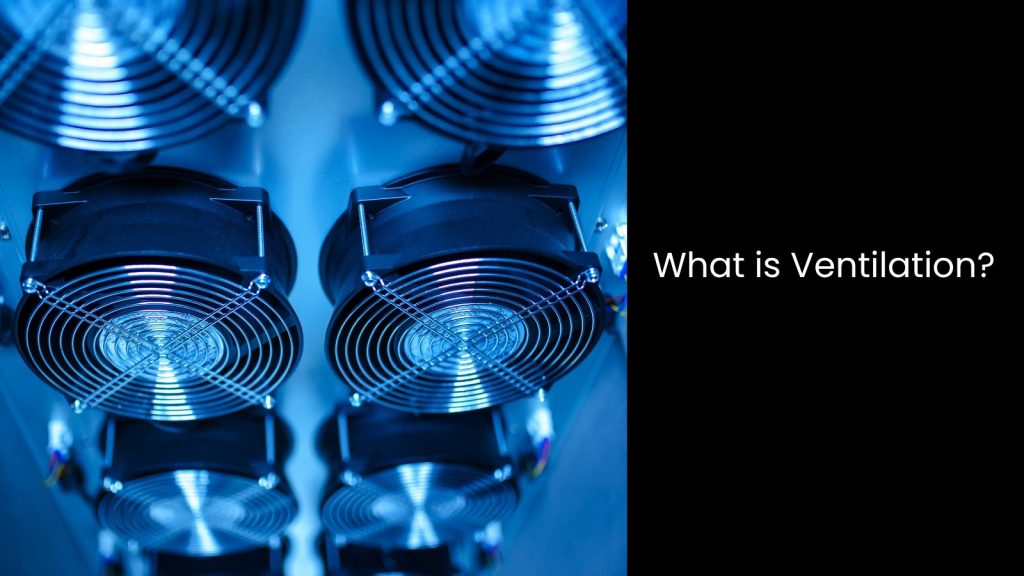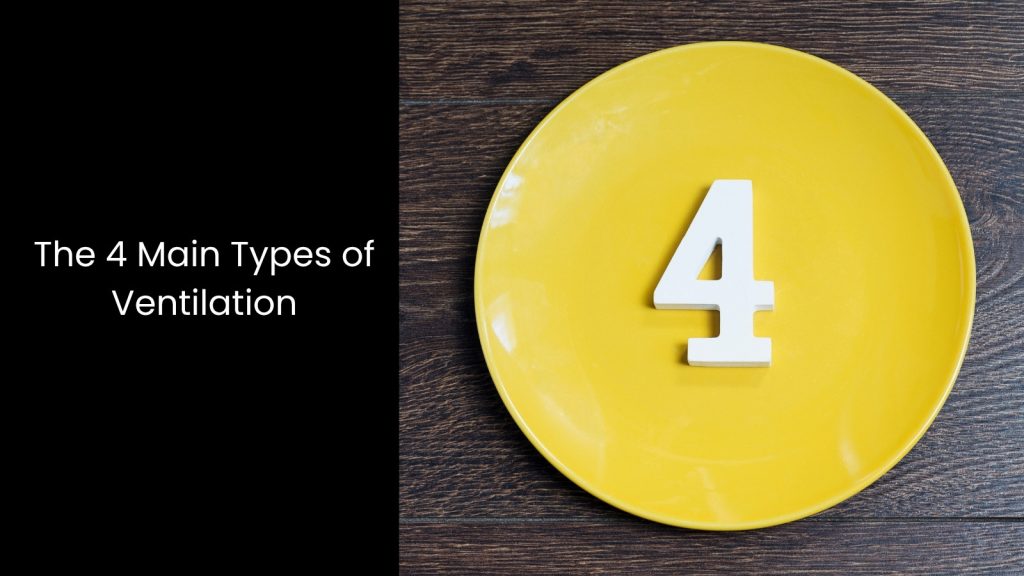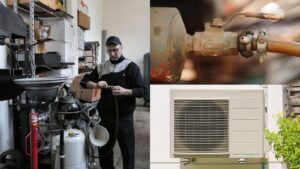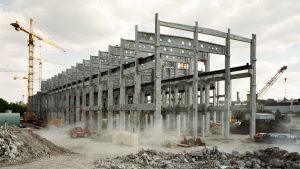Poor air circulation in industrial workplaces can lead to major problems, from worker illness to equipment breakdowns. It is the method that moves fresh air through buildings and removes contaminated air. This is where understanding the importance of ventilation helps businesses protect both their teams and their tools.
This article explains four key types of ventilation that every industrial facility should consider for safer and more efficient operations.
This article explains four key types of ventilation that every industrial facility should consider for safer and more efficient operations.
What is Ventilation?

- Ventilation means bringing fresh air into a building while pushing out stale or polluted air to keep the space healthy and comfortable. In factories or large workplaces, industrial ventilation systems use fans, ducts, and vents to move air around, controlling things like indoor air quality, moisture levels, and temperature.
- These systems work hard to remove harmful dust, fumes, and chemicals that machines and processes often produce. When ventilation does not work well, the air inside can become stuffy and humid, which leads to discomfort and health problems like headaches, allergies, or respiratory issues.
- Damp conditions can also cause mould growth, which damages buildings and creates more health risks. Besides making people sick, poor ventilation forces heating and cooling equipment to work harder, wasting energy and raising bills.
- This is when good ventilation systems make sure air keeps moving so workers stay safe and comfortable, and buildings run more efficiently. Without this airflow, rooms can trap pollutants and moisture, which creates a cycle of problems that affect both health and energy use.
- So, strong industrial ventilation plays a big role in keeping environments fresh, safe, and easier to manage every day.
The 4 Main Types of Ventilation

Natural Ventilation
Natural ventilation works by using wind and thermal buoyancy, the way warm air rises, to move fresh air through buildings without needing machines. It relies on simple openings like windows, vents, and louvres to let air flow in and out, creating a constant exchange that refreshes indoor spaces.
This type of passive ventilation saves energy because it does not use fans or motors, which keeps costs low and reduces electricity use.
We see people tend to choose natural ventilation in places with mild weather where outdoor air feels comfortable most of the year. It fits well in homes or buildings designed with open layouts and clear paths for air to travel.
However, natural ventilation depends heavily on the weather. On windy days, airflow improves, but on still or very hot days, it can struggle to keep air moving consistently. This means the indoor environment might not always stay fresh or cool. Even so, natural ventilation remains an eco-friendly ventilation option as it lowers reliance on artificial cooling and heating.
While it might not work perfectly in every climate, it suits temperate regions and spaces built to take advantage of natural breezes. The latter offers a simple, energy-saving way to improve air quality, but it needs thoughtful design and the right climate to work best.
This type of passive ventilation saves energy because it does not use fans or motors, which keeps costs low and reduces electricity use.
We see people tend to choose natural ventilation in places with mild weather where outdoor air feels comfortable most of the year. It fits well in homes or buildings designed with open layouts and clear paths for air to travel.
However, natural ventilation depends heavily on the weather. On windy days, airflow improves, but on still or very hot days, it can struggle to keep air moving consistently. This means the indoor environment might not always stay fresh or cool. Even so, natural ventilation remains an eco-friendly ventilation option as it lowers reliance on artificial cooling and heating.
While it might not work perfectly in every climate, it suits temperate regions and spaces built to take advantage of natural breezes. The latter offers a simple, energy-saving way to improve air quality, but it needs thoughtful design and the right climate to work best.
Mechanical Ventilation
This type of ventilation uses fans and duct systems to pull in fresh air and push out stale air, making sure indoor spaces always stay breathable and comfortable. This setup, also called forced ventilation, runs with different types like supply ventilation, exhaust ventilation, and balanced ventilation.
When it comes to the supply systems, they push clean air into a space, exhaust systems remove dirty or humid air, and balanced systems do both at the same time to keep air pressure steady. The industrial world installs mechanical ventilation in places where natural airflow does not work well, such as in tightly sealed, energy-efficient homes or large commercial buildings that need constant air movement.
One big advantage is that it works in any climate, hot, cold, humid, or dry, and gives better control over air quality. It helps remove dust, allergens, moisture, and odours, which creates a safer and more pleasant indoor environment.
However, this kind of system does come with some downsides. It uses more energy than natural airflow because fans and controls run often, and it also needs regular maintenance to keep everything running smoothly. Still, many choose HVAC systems with mechanical ventilation, as it offers a reliable way to manage indoor air year-round.
When it comes to the supply systems, they push clean air into a space, exhaust systems remove dirty or humid air, and balanced systems do both at the same time to keep air pressure steady. The industrial world installs mechanical ventilation in places where natural airflow does not work well, such as in tightly sealed, energy-efficient homes or large commercial buildings that need constant air movement.
One big advantage is that it works in any climate, hot, cold, humid, or dry, and gives better control over air quality. It helps remove dust, allergens, moisture, and odours, which creates a safer and more pleasant indoor environment.
However, this kind of system does come with some downsides. It uses more energy than natural airflow because fans and controls run often, and it also needs regular maintenance to keep everything running smoothly. Still, many choose HVAC systems with mechanical ventilation, as it offers a reliable way to manage indoor air year-round.
Exhaust Ventilation
Exhaust ventilation works by pulling stale, humid, or smelly air out of a space using exhaust fans, which helps keep the indoor air fresh and clean. You usually find this system in places like kitchens, bathrooms, and sewage plants, where steam, smoke, or harmful gases build up fast.
The idea is simple. It is to get the bad air out before it causes problems. This method works well in single rooms or small areas that deal with a lot of moisture or strong odours. People rely on exhaust ventilation to remove pollutants, control humidity, and stop mould or bacteria from growing in damp places.
For example, bathroom fans take out warm, wet air after a shower, while kitchen fans pull smoke and grease out during cooking. In industrial setups or sewage plants, these systems protect workers from breathing in dangerous fumes.
Even though this setup sounds like a win, it does have another side. If the design does not match the building’s airflow, it can mess with the pressure inside, which might pull in dirty outdoor air or make other ventilation systems struggle. So, while exhaust fans work great in high-moisture spots or specific rooms, they need careful planning to avoid creating airflow problems in the rest of the building.
The idea is simple. It is to get the bad air out before it causes problems. This method works well in single rooms or small areas that deal with a lot of moisture or strong odours. People rely on exhaust ventilation to remove pollutants, control humidity, and stop mould or bacteria from growing in damp places.
For example, bathroom fans take out warm, wet air after a shower, while kitchen fans pull smoke and grease out during cooking. In industrial setups or sewage plants, these systems protect workers from breathing in dangerous fumes.
Even though this setup sounds like a win, it does have another side. If the design does not match the building’s airflow, it can mess with the pressure inside, which might pull in dirty outdoor air or make other ventilation systems struggle. So, while exhaust fans work great in high-moisture spots or specific rooms, they need careful planning to avoid creating airflow problems in the rest of the building.
Hybrid Ventilation
This sort of ventilation blends natural airflow with mechanical systems to give buildings more control over air movement and energy use. This mix, also known as mixed-mode ventilation, lets a space switch between using outdoor breezes and powered fans depending on what the building needs at the time.
For example, during cool mornings, the system might open windows with automated window openers to let in fresh air. Then, as the day gets hotter or more humid, it can close those windows and turn on motorised vents or fans to keep air moving. This kind of smart ventilation helps save energy while still making the air inside feel fresh and comfortable.
People use hybrid ventilation in smart homes and green buildings that focus on comfort without wasting power. It allows flexibility; when nature fulfils its duty, machines can rest, and when nature does not help, technology steps in.
Still, this setup comes with some challenges. It costs more to install and takes some smart planning to make sure everything works together without glitches. Plus, it needs sensors and controls to know when to switch between modes. Even though it sounds fancy, it simply gives buildings the best of both circumstances: fresh air when possible and reliable airflow when needed.
For example, during cool mornings, the system might open windows with automated window openers to let in fresh air. Then, as the day gets hotter or more humid, it can close those windows and turn on motorised vents or fans to keep air moving. This kind of smart ventilation helps save energy while still making the air inside feel fresh and comfortable.
People use hybrid ventilation in smart homes and green buildings that focus on comfort without wasting power. It allows flexibility; when nature fulfils its duty, machines can rest, and when nature does not help, technology steps in.
Still, this setup comes with some challenges. It costs more to install and takes some smart planning to make sure everything works together without glitches. Plus, it needs sensors and controls to know when to switch between modes. Even though it sounds fancy, it simply gives buildings the best of both circumstances: fresh air when possible and reliable airflow when needed.
Ensuring Quality Ventilation Mechanism via Robust Tools

Every quality ventilation setup needs more than just hardware; it needs insight. Mechanical fans play a big part, but managing them with comprehensive mechanical asset management software ensures they stay in peak condition. With real-time data and smart scheduling, industrialists can reduce downtime and keep indoor air fresh, proving that smart tools build better environments.







